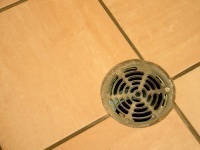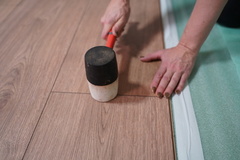Replacing Bathroom Floor for the Last Time
Updated: 2020-12-09
By Bill & Kevin Burnett
Inman News
 Q: We have had to replace the bathroom floor in our rental four times in the past 10 years because of leaking toilets or tenants who are not careful while showering or bathing. Each time we have had to repair the sub-floor and re-cover with vinyl. It has been recommended that we use ceramic tile because the water will not penetrate to the sub-floor. Do you agree or have any suggestions regarding this problem?A: It's time to replace your bathroom floor one more time - then forget about it. That means tile. You can cut the cost of installation by 75 percent by investing a day or two of your time and doing it yourself. It's not brain surgery and your rental is a great place to practice.
Q: We have had to replace the bathroom floor in our rental four times in the past 10 years because of leaking toilets or tenants who are not careful while showering or bathing. Each time we have had to repair the sub-floor and re-cover with vinyl. It has been recommended that we use ceramic tile because the water will not penetrate to the sub-floor. Do you agree or have any suggestions regarding this problem?A: It's time to replace your bathroom floor one more time - then forget about it. That means tile. You can cut the cost of installation by 75 percent by investing a day or two of your time and doing it yourself. It's not brain surgery and your rental is a great place to practice.
There is no question that tile is the solution. In our experience, the chance of tub water causing damage to a properly installed tile floor is slim or none.
Water from a leaky toilet is another matter. Regardless of the finished floor covering, a leaky seal under the bowl allows water to get at the sub-floor. With a little care, however, you can install a leak-proof toilet.
But first, your new tile floor.
Begin by tearing up the old floor. Remove any baseboard using a flat bar. Gently pry the base away from the wall. Save the pieces so you can reinstall them after the new floor is down.
Next, remove the toilet. Turn the water off and flush the toilet. With a sponge remove any standing water left in the tank. On each side of the base of the toilet is a bolt with a nut and usually a plastic cover. These are called closet bolts. Remove the plastic cover and unscrew the nut. Then lift the toilet off the flange. Scrape the wax seal off the base and put the toilet in a safe place - the tub or shower works well. Stuff a rag down the sewer pipe to avoid unwanted debris going down the drain.
Your bathroom floor is most likely made up of three layers - the vinyl, a particleboard underlayment and a plywood sub-floor. Set a circular saw to a depth of 3/8 inch and cut about a 1-foot square piece out of the middle of the floor. You may have to go a little deeper to get through the underlayment. Avoid cutting the sub-floor. After removing the cutout, pry up the rest of the floor and take it to the dump. A flat bar or flat shovel is your best tool for this job.
Now it's time for your new floor. We strongly recommend that you use a cementitious backer board - such as DuRock or WonderBoard - as a base for the tile.
Install the backer board with stainless steel screws and seal any seams with fiberglass tape imbedded in thin-set mortar. Also run the thin-set next to the walls to fill any voids where the wall meets the floor. Run a bead of silicon caulk where the tub meets the floor.
After the backer board is down and the seams are dry - an hour or two - install the tile.
To lay out the tile, draw parallel lines from two perpendicular walls. Place a tile at the intersection and more tiles on each side until each leg reaches a wall. Adjust the tiles until there are full tiles in each line. This will reduce the amount of cutting.
Use a notched trowel to spread the mortar over the floor and set the tile on the mortar. With the flat edge of a two-by-four, lightly tap the tile to make sure that all pieces are set evenly. You will have to cut a few tiles. Depending on the type of tile and the intricacy of the cuts, use either a tile cutter or tile saw.
Cutters are relatively inexpensive and tile saws are available for a reasonable rent at a rental center. Once all tile is set, let it dry - usually overnight.
Grout the joints the next day. We'd also suggest you seal the grout after it is dry to further prevent water penetration. Reinstall the baseboard. Carefully reset the toilet, making sure to use a new wax ring with a plastic horn and new closet bolts.
We know this sounds complicated, but it really isn't. Most home improvement centers or local hardware stores are well stocked with tools, supplies, tile and advice. Many big box centers even have free classes in tile setting, often conducted by retired professionals.
After you replace the vinyl with tile, your days of changing floors every time you change tenants should be over.
 Q: We have had to replace the bathroom floor in our rental four times in the past 10 years because of leaking toilets or tenants who are not careful while showering or bathing. Each time we have had to repair the sub-floor and re-cover with vinyl. It has been recommended that we use ceramic tile because the water will not penetrate to the sub-floor. Do you agree or have any suggestions regarding this problem?A: It's time to replace your bathroom floor one more time - then forget about it. That means tile. You can cut the cost of installation by 75 percent by investing a day or two of your time and doing it yourself. It's not brain surgery and your rental is a great place to practice.
Q: We have had to replace the bathroom floor in our rental four times in the past 10 years because of leaking toilets or tenants who are not careful while showering or bathing. Each time we have had to repair the sub-floor and re-cover with vinyl. It has been recommended that we use ceramic tile because the water will not penetrate to the sub-floor. Do you agree or have any suggestions regarding this problem?A: It's time to replace your bathroom floor one more time - then forget about it. That means tile. You can cut the cost of installation by 75 percent by investing a day or two of your time and doing it yourself. It's not brain surgery and your rental is a great place to practice.There is no question that tile is the solution. In our experience, the chance of tub water causing damage to a properly installed tile floor is slim or none.
Water from a leaky toilet is another matter. Regardless of the finished floor covering, a leaky seal under the bowl allows water to get at the sub-floor. With a little care, however, you can install a leak-proof toilet.
But first, your new tile floor.
Begin by tearing up the old floor. Remove any baseboard using a flat bar. Gently pry the base away from the wall. Save the pieces so you can reinstall them after the new floor is down.
Next, remove the toilet. Turn the water off and flush the toilet. With a sponge remove any standing water left in the tank. On each side of the base of the toilet is a bolt with a nut and usually a plastic cover. These are called closet bolts. Remove the plastic cover and unscrew the nut. Then lift the toilet off the flange. Scrape the wax seal off the base and put the toilet in a safe place - the tub or shower works well. Stuff a rag down the sewer pipe to avoid unwanted debris going down the drain.
Your bathroom floor is most likely made up of three layers - the vinyl, a particleboard underlayment and a plywood sub-floor. Set a circular saw to a depth of 3/8 inch and cut about a 1-foot square piece out of the middle of the floor. You may have to go a little deeper to get through the underlayment. Avoid cutting the sub-floor. After removing the cutout, pry up the rest of the floor and take it to the dump. A flat bar or flat shovel is your best tool for this job.
Now it's time for your new floor. We strongly recommend that you use a cementitious backer board - such as DuRock or WonderBoard - as a base for the tile.
Install the backer board with stainless steel screws and seal any seams with fiberglass tape imbedded in thin-set mortar. Also run the thin-set next to the walls to fill any voids where the wall meets the floor. Run a bead of silicon caulk where the tub meets the floor.
After the backer board is down and the seams are dry - an hour or two - install the tile.
To lay out the tile, draw parallel lines from two perpendicular walls. Place a tile at the intersection and more tiles on each side until each leg reaches a wall. Adjust the tiles until there are full tiles in each line. This will reduce the amount of cutting.
Use a notched trowel to spread the mortar over the floor and set the tile on the mortar. With the flat edge of a two-by-four, lightly tap the tile to make sure that all pieces are set evenly. You will have to cut a few tiles. Depending on the type of tile and the intricacy of the cuts, use either a tile cutter or tile saw.
Cutters are relatively inexpensive and tile saws are available for a reasonable rent at a rental center. Once all tile is set, let it dry - usually overnight.
Grout the joints the next day. We'd also suggest you seal the grout after it is dry to further prevent water penetration. Reinstall the baseboard. Carefully reset the toilet, making sure to use a new wax ring with a plastic horn and new closet bolts.
We know this sounds complicated, but it really isn't. Most home improvement centers or local hardware stores are well stocked with tools, supplies, tile and advice. Many big box centers even have free classes in tile setting, often conducted by retired professionals.
After you replace the vinyl with tile, your days of changing floors every time you change tenants should be over.
View more similar articles in Flooring
Comments (0)


